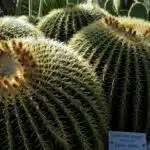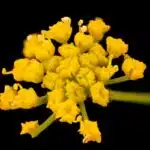Golden Star (Chrysogonum virginianum) is a perennial herbaceous plant that belongs to the family Asteraceae. It is native to eastern North America and can be found growing in various habitats such as woodlands, meadows, and along stream banks. Golden Star is a popular choice among gardeners due to its bright yellow flowers and ability to attract pollinators like bees and butterflies.
In this article, we will explore the different aspects of growing and caring for Golden Star. As horticulturists, it is essential to understand the plant’s requirements for optimal growth and development. From soil preparation to watering techniques, we will provide practical advice on how to cultivate healthy plants that thrive in their environment. Whether you are a novice gardener or an experienced horticulturist, our guide will equip you with the knowledge you need to successfully grow and care for Golden Star.
Understanding Golden Star’s Botanical Characteristics
Golden star, also known as Chrysogonum virginianum, is a perennial herbaceous plant that belongs to the Asteraceae family. This plant is native to the southeastern United States and can be found in woodlands, meadows, and along stream banks. Golden star grows up to 30 cm tall and spreads easily through its rhizomes.
The leaves of golden star are evergreen, forming basal rosettes that are shiny, dark green, and oval-shaped. The leaves are about 5-10 cm long and have serrated edges. The flowers of golden star bloom from spring to fall and are bright yellow with five petals that form a daisy-like shape. They grow on stems that rise above the foliage and can reach up to 45 cm tall.
Golden star prefers moist soil that is rich in organic matter and well-drained. It thrives in partial shade but can also tolerate full sun if it receives adequate moisture. This plant is low-maintenance and does not require much attention once established. However, it benefits from regular watering during hot weather or prolonged periods of drought. In the next section, we will discuss how to choose the right location for growing golden star based on these growth habits.
Choosing The Right Location For Growing Golden Star
When choosing the right location for growing golden star, it is important to consider the plant’s light and soil requirements. This will ensure that the plant thrives and produces beautiful blooms. Golden star is a versatile plant that can grow in both sun and shade, but certain factors must be taken into account.
Sun vs. shade: Golden star can grow in full sun to partial shade, but it tends to bloom more profusely in areas with more sunlight. If grown in too much shade, the plant may become leggy and produce fewer flowers. On the other hand, if grown in full sun without adequate water, the plant may suffer from heat stress and wilt.
Soil type: Golden star prefers well-draining soils that are rich in organic matter. It can tolerate a range of soil types but does best in loamy soils with a pH range of 5.0-7.0. When planting golden star, it is important to amend heavy clay soils with compost or sand to improve drainage and prevent root rot.
- If planting in full sun, provide some afternoon shade during hot summer months
- Apply a layer of mulch around the base of the plant to retain moisture
- Avoid planting near trees or shrubs that may compete for nutrients and water
Preparing the soil for golden star is crucial for its growth and development. By providing a suitable environment for this plant, gardeners can expect healthy growth and abundant blooms. In the next section, we will discuss how to prepare your soil for optimal golden star growth.
Preparing The Soil For Golden Star
After choosing the right location for growing golden star, it is essential to prepare the soil adequately. Soil preparation plays a vital role in ensuring healthy growth and optimum yield of plants. Did you know that amending soil with organic matter can significantly improve soil quality? According to research, adding organic matter to the soil can enhance its water-holding capacity, nutrient content, and structure.
One of the most crucial aspects of preparing soil for golden star is improving drainage. Golden star prefers well-drained soils as excessive moisture can cause root rot and other fungal diseases. Inadequate drainage also leads to waterlogging, which inhibits plant growth and reduces yields. Therefore, it is essential to ensure proper drainage by incorporating coarse sand or gravel into the soil.
Amending soil with organic matter and improving drainage are two critical factors in preparing the perfect bed for your golden star plants. Organic matter improves nutrient availability, while drainage improvement ensures that water does not stagnate around the roots. Incorporating these practices will provide your plants with an environment conducive for healthy growth and development.
Transitioning into planting golden star seeds, it is crucial to keep in mind that they require a well-prepared bed with adequate nutrients and good drainage conditions.
Planting Golden Star Seeds
Golden star seeds can be sown directly into the ground in late spring or early fall. Before planting, it is important to prepare the soil by loosening it and removing any weeds. Seeds should be planted at a depth of 1/8 inch and spaced about 12 inches apart. Water gently but thoroughly after planting.
Seed germination typically takes around two weeks. Once the seedlings have emerged, thin them out so that they are spaced about 18 inches apart. This will give each plant enough room to grow and thrive. Golden star plants prefer full sun to partial shade and well-draining soil.
When transplanting golden star seedlings, be sure to handle them carefully as their roots are delicate. It is recommended to transplant them when they have grown at least two sets of true leaves. Gently loosen the soil around the seedling and lift it out with a trowel or garden fork, being careful not to damage the roots. Transplant into prepared soil, spacing them 18 inches apart, and water thoroughly.
In order to propagate golden star through division, established plants should be dug up in early spring or late fall when they are dormant. The clump can then be divided into smaller sections using a sharp knife or garden fork. Each section should have several healthy shoots and a good root system attached. Replant these sections in prepared soil at the same depth they were previously growing and water well. With proper care, these divisions will establish quickly and produce new growth within weeks.
Propagating Golden Star Through Division
One of the best ways to propagate golden star is through division. This method involves separating an established plant into smaller sections, each with its own roots and shoots. To start, dig up the entire plant during its dormant season, which occurs in late fall or early spring. Gently shake off the soil from the roots and cut the clump into smaller sections using a sharp knife or garden shears.
Propagation techniques for golden star through division vary depending on the size of the clump and how many new plants you want to create. Here are three common methods:
Halving: Cut the clump in half, making sure each section has enough roots and foliage to survive.
Quartering: Divide the clump into four equal parts, ensuring that each section has at least one strong shoot and several healthy roots.
Multiple divisions: For larger clumps, divide them into as many sections as possible while still maintaining a healthy root system and foliage.
The best time to propagate golden star through division is during its dormant season in late fall or early spring when it is not actively growing. This will give the new plants a chance to establish their root systems before they need to support new growth. Once divided, replant each section in well-draining soil and water thoroughly before placing them in a partially shaded area until new growth appears.
To ensure your newly propagated golden star plants thrive, proper watering techniques are essential. Water deeply once a week during dry spells, making sure to soak the soil around each plant’s base thoroughly. Avoid overwatering as this can cause root rot and other problems that may negatively impact your plants’ health. In addition, be sure to mulch around each plant’s base to help retain moisture and prevent weeds from competing for nutrients with your new golden star seedlings.
Watering Golden Star
Watering frequency is an important aspect of caring for golden star plants. The soil should be kept evenly moist but not waterlogged. Overwatering can lead to root rot, so it is important to allow the soil to dry out slightly between watering sessions. During the summer months, when temperatures are high and the plant is actively growing, watering may need to occur more frequently.
Soil moisture levels can be monitored by sticking a finger into the soil up to the first knuckle. If the soil feels dry at this depth, it is time to water. Another method of monitoring moisture levels is by using a moisture meter. These devices can be purchased at most gardening stores and provide an accurate reading of the moisture content in the soil.
| Watering Frequency | Soil Moisture Level |
|---|---|
| Spring/Fall | Allow topsoil to dry |
| Summer | Keep soil evenly moist |
| Winter | Allow topsoil to dry |
To maintain healthy golden star plants, it is crucial to understand their watering needs. Proper watering frequency ensures that the plant’s roots receive adequate hydration while also preventing issues such as root rot. By monitoring soil moisture levels and adjusting watering accordingly, gardeners can keep their golden stars thriving and beautiful.
Transition into subsequent section: Now that we have covered how to properly water your golden star plant, let’s move on to fertilizing it for optimal growth and health.
Fertilizing Golden Star
Fertilizing is an essential part of maintaining the health and beauty of your golden star plant. When it comes to fertilizers, there are two main types: organic and synthetic. Organic fertilizers are made from natural ingredients such as compost, manure, and fish emulsion. They release nutrients slowly over time, providing a steady supply of food for your plants. Synthetic fertilizers, on the other hand, contain concentrated amounts of nutrients that are quickly absorbed by plants. While they can be effective in promoting fast growth, they can also lead to nutrient burn if used improperly.
Before deciding which fertilizer to use for your golden star plant, it’s important to consider its individual needs. These plants prefer a slightly acidic soil pH between 5.0 and 6.5, so choosing a fertilizer that is formulated for acid-loving plants may be beneficial. Additionally, golden stars thrive in well-draining soil that is rich in organic matter.
When applying fertilizer to your golden star plant, it’s important to follow the manufacturer’s instructions carefully. Over-fertilizing can cause damage to the roots and leaves of your plant, leading to stunted growth or even death. It’s recommended to fertilize once a month during the growing season (spring through fall) with a balanced fertilizer that contains equal amounts of nitrogen, phosphorus, and potassium.
In summary, choosing the right type of fertilizer for your golden star plant is crucial in ensuring its health and vibrant appearance. Be sure to take into account its specific needs when selecting a product and apply it according to instructions to avoid damaging your plant. In the next section, we will discuss how pruning can further promote optimal growth for your golden star plant without causing any harm or stress.
Pruning Golden Star
Pruning Golden Star is essential in keeping the plant healthy and attractive. By removing dead, damaged or diseased parts, you increase airflow and light penetration to the center of the plant. Pruning also encourages new growth and prevents overcrowding.
Pruning techniques for Golden Star include removing dead leaves, cutting back stems that are too long, and trimming off any weak or crossing branches. You can use pruning shears or scissors to make clean cuts at a 45-degree angle. Be sure to sterilize your tools before and after each use to prevent the spread of diseases.
Maintenance tips for pruning Golden Star include doing it during the dormant period in late winter or early spring when there is less stress on the plant. You should avoid over-pruning your plant as it can lead to stunted growth or even death. Regularly inspect your plant for any signs of pests, disease or damage to address them promptly. By following these maintenance tips, you will ensure a healthy and vibrant Golden Star plant in your garden.
Transition: Now that you know how to prune your Golden Star effectively let’s move on to another critical aspect of caring for this plant- dealing with pests and diseases.
Dealing With Pests And Diseases
Golden star is an easy-to-grow plant that requires minimal maintenance. However, pests and diseases can still affect its growth if not taken care of properly. Natural pest control methods are the best way to ensure that your plant remains healthy and free from any harmful chemicals.
To prevent pests from attacking your golden star, consider planting companion plants such as marigold, lavender, or mint. These plants repel common pests like aphids, spider mites, and whiteflies. Additionally, you can use natural pest control methods like neem oil or diatomaceous earth to control insect infestations without harming beneficial insects like bees and ladybugs.
Identifying plant diseases is also essential in maintaining the health of your golden star. One common disease is powdery mildew, which appears as a white powdery substance on leaves and stems. To prevent powdery mildew from spreading, remove infected leaves immediately and avoid overhead watering. Another disease to watch out for is root rot, which causes stunted growth and yellowing of leaves. Ensure proper drainage and avoid overwatering to prevent root rot.
As a horticulturist, it is crucial to be proactive in preventing pest infestations and identifying plant diseases early on. Utilizing natural pest control methods and promptly addressing any signs of disease will keep your golden star flourishing. With these tips in mind, you can ensure a healthy garden that provides beautiful blooms for all to enjoy.
Moving forward into harvesting golden star, it is important to know when the right time is to harvest the flowers for maximum freshness and longevity.
Harvesting Golden Star
Harvesting Golden Star is an essential step in maintaining the health and vigor of this plant. It is important to wait until the flowers are fully bloomed before beginning the harvesting process. This ensures that the flowers will have reached their maximum size and color, providing a visually appealing display.
Golden star harvesting techniques vary depending on the desired use of the flowers. For fresh cuttings, it is best to harvest early in the morning when the plants are still cool and hydrated. Cut stems at a 45-degree angle, removing any damaged or diseased foliage. To preserve golden star flowers, it is recommended to hang them upside down in a cool, dry space for several weeks until they are completely dried.
Preserved golden star flowers can be used in various ways including flower arrangements, wreaths, or as decorative accents in home décor. They add a touch of elegance and natural beauty to any space. In addition to their aesthetic appeal, golden star flowers also hold historical significance as an ancient Chinese herbal remedy for ailments such as fever and inflammation.
Harvesting Golden Star provides an opportunity to appreciate the beauty of nature while also preserving its gifts for future use in landscaping and design. The delicate blooms of this plant can be incorporated into garden beds or used as borders along walkways. Their unique shape adds texture and depth to any landscape design. In the next section, we will explore different ways that golden star can be utilized in landscaping and design projects without compromising their natural beauty.
Using Golden Star In Landscaping And Design
Golden Star (Chrysogonum virginianum) is a popular ornamental plant due to its yellow, star-shaped flowers, and it is a great addition to any landscape design. When planting Golden Star, it is important to consider a location that receives full sun and has well-drained soil. In addition, when planting, it is important to keep the soil evenly moist and mulch the plants to maintain soil moisture. Finally, to ensure the best health for the plants, regular pruning is recommended to remove any dead or damaged foliage.
Landscape Design
Golden star is a versatile plant that can be used in various landscape designs. Its bright yellow flowers can add a splash of color to any garden or lawn, making it an excellent choice for individuals who want to create a vibrant outdoor space. When combined with other plants, golden star can create stunning color combinations that will make any yard stand out.
Design elements that complement golden star include rocks, fountains, and pathways. These features help to create an aesthetically pleasing environment that allows the plant to shine. Rocks and fountains provide a naturalistic feel that enhances the beauty of this yellow-flowered perennial. Pathways help to guide visitors through the garden and highlight the unique features of each plant.
To grow and care for golden star, ensure that it is planted in well-draining soil with partial shade. Water regularly during the growing season but avoid overwatering as this may lead to root rot. Prune the plant after flowering to encourage new growth and maintain its shape. With proper care, golden star will bloom year after year, providing homeowners with an attractive addition to their landscape design.
Planting Techniques
Golden star is not only an attractive plant to incorporate into landscaping designs but also a versatile one that can thrive in various planting techniques. One option is companion planting, which involves growing golden star alongside other plants that have similar light and water requirements. Good companion plants for golden star include black-eyed Susan, coneflower, and bee balm. These plants complement each other in terms of color, texture and blooming patterns.
Container gardening is another planting technique that is suitable for Golden star. This method allows gardeners to grow the plant in pots or containers rather than directly in the ground. Container gardening offers flexibility as it allows gardeners to move the plant around as needed while providing an excellent opportunity to experiment with different design ideas.
When planting golden star using either companion planting or container gardening techniques, it’s essential to ensure that the soil has good drainage and partial shade conditions. In addition, regular watering during dry spells will help the plant thrive. With these techniques, homeowners can enjoy the beauty of this yellow-flowered perennial in their gardens or patios year-round.
Overwintering Golden Star
Like a bear hibernating during winter, golden star needs to be protected from the harsh weather conditions. To ensure that your golden star survives through winter, it is crucial to provide adequate winter protection. Golden star has good frost tolerance and can withstand temperatures as low as -10°C; however, this does not mean you should leave it unprotected.
One of the best ways to protect your golden star during winter is by mulching. Mulching involves covering the ground around the plant with organic matter such as leaves, straw or compost. This helps to insulate the soil and regulate temperature fluctuations, which in turn protects the roots from freezing. Additionally, you can cover your golden star with burlap or frost cloth to protect its foliage from frost damage.
It is important to note that one common mistake people make when overwintering golden star is providing too much water. While it may seem intuitive to water your plants more frequently during winter, this can actually harm them. Overwatering can lead to root rot and fungal diseases, which are more prevalent in cold and wet conditions. Therefore, it is advisable to reduce watering frequency during winter while ensuring that the soil remains moist but not waterlogged.
Common Mistakes To Avoid When Growing Golden Star
After successfully overwintering your golden star, the next step is to grow and care for it. However, there are common mistakes that beginners should avoid to ensure the plant’s healthy growth.
One of the most common mistakes is overwatering. Golden star prefers well-draining soil and cannot tolerate standing water. Water only when the top inch of soil feels dry to touch. Another mistake to avoid is planting in a location with too much shade. Golden star needs at least six hours of direct sunlight each day to thrive.
To ensure successful growth, provide regular fertilization during the growing season, preferably every two weeks using a balanced fertilizer. Additionally, deadheading spent flowers can prolong blooming and promote bushier growth.
Tips for Beginners:
- Always check soil moisture before watering and use well-draining soil.
- Ensure enough sunlight by planting in a location with at least six hours of direct sunlight.
- Fertilize regularly during the growing season every two weeks using a balanced fertilizer.
- Deadhead spent flowers for prolonged blooming and bushier growth.
In summary, understanding and avoiding common mistakes in growing and caring for golden star is crucial for its optimal health and beauty. By following these tips, beginners can enjoy a thriving golden star plant in their gardens or indoor spaces. However, even with proper care, issues may arise, so it’s important to know how to troubleshoot problems that may occur with this plant.
Troubleshooting Golden Star Problems
Identifying diseases and managing pest infestations are important components of maintaining the health of your golden star plant. One common disease that affects golden stars is powdery mildew, which appears as a white or gray powder on the leaves. This can be prevented by avoiding overhead watering and ensuring good air circulation around the plant. If powdery mildew does occur, it can be treated with a fungicide.
Another issue that may arise is root rot, which is caused by overwatering or poor drainage. Symptoms include yellowing leaves and a mushy, blackened root system. To prevent root rot, make sure to water your golden star plant only when the top inch of soil is dry and ensure that its pot has adequate drainage holes. If root rot does occur, you may need to repot the plant in fresh soil and trim away any damaged roots.
Golden stars can also fall victim to various pests such as spider mites or aphids. These can be managed through regular inspection and treatment with insecticidal soap or neem oil spray. It is important to catch infestations early before they spread to other nearby plants.
| Disease/Pest | Symptoms | Management |
|---|---|---|
| Powdery mildew | White/gray powder on leaves | Avoid overhead watering, good air circulation, fungicide if necessary |
| Root rot | Yellowing leaves, blackened roots | Water only when top inch of soil is dry, ensure proper drainage; repot in fresh soil if necessary |
| Pests (e.g. spider mites, aphids) | Visible insects on leaves/stems | Regular inspection and treatment with insecticidal soap or neem oil spray |
Moving forward into frequently asked questions about growing and caring for golden star plants, it is important to remember that prevention is key when it comes to identifying diseases and managing pest infestations. By providing your plant with proper care and regular inspection, you can help keep it healthy and thriving.
Frequently Asked Questions About Growing And Caring For Golden Star
As we discussed in the previous section, golden star plants may face various problems that can hinder their growth and vitality. However, with proper care and attention, these issues can be addressed effectively. In this section, we will address some frequently asked questions about growing and caring for golden star plants.
Firstly, let’s talk about propagation. Golden stars can be propagated through division or seeds. Division should be done in early spring or fall when the plant is dormant. Seeds should be sown indoors in late winter or directly outdoors in spring after the last frost. It is important to note that golden stars prefer well-draining soil and a pH level of 5.5 to 7.
Secondly, let’s discuss soil pH for golden star plants in more detail. Soil acidity affects nutrient availability to plants, so it is crucial to maintain the right pH level for optimal growth. If your soil is too acidic (below 5.5), add lime to raise the pH level gradually. On the other hand, if your soil is too alkaline (above 7), add sulfur or peat moss to lower the pH level.
By taking care of your golden star plant’s propagation method and maintaining an appropriate soil pH level, you can ensure healthy growth and a thriving plant. Remember to water regularly but not overwater as this can cause root rot. With patience and dedication, you’ll soon enjoy the beautiful blooms of your golden star plant!
Conclusion
Golden Star is a plant with unique botanical characteristics that can thrive in various environments. When choosing a location for growing Golden Star, it is crucial to consider factors such as sunlight exposure and soil drainage. Preparing the soil by adding organic matter and ensuring proper drainage can help promote healthy growth. Planting Golden Star seeds or propagating through division are effective methods of propagation.
Overwintering Golden Star requires pruning and mulching to protect the plant from frost damage. Common mistakes when growing Golden Star include overwatering or planting in poorly drained soil. Troubleshooting problems such as yellowing leaves or pest infestations require prompt action to prevent further damage.
In conclusion, growing and caring for Golden Star is an enjoyable experience that requires patience, attention to detail, and dedication. As horticulturists, we must understand the unique botanical characteristics of each plant species and provide optimal conditions for their growth. Like nurturing a garden, we must cultivate our skills over time to achieve successful results. The metaphorical journey of growing Golden Star represents the journey of life itself; it may be challenging at times, but ultimately rewarding when we see the fruits of our labor flourish.
Image Credits
- “Hubble Eyes Golden Rings of Star Formation” by NASA Goddard Photo and Video (featured)





























